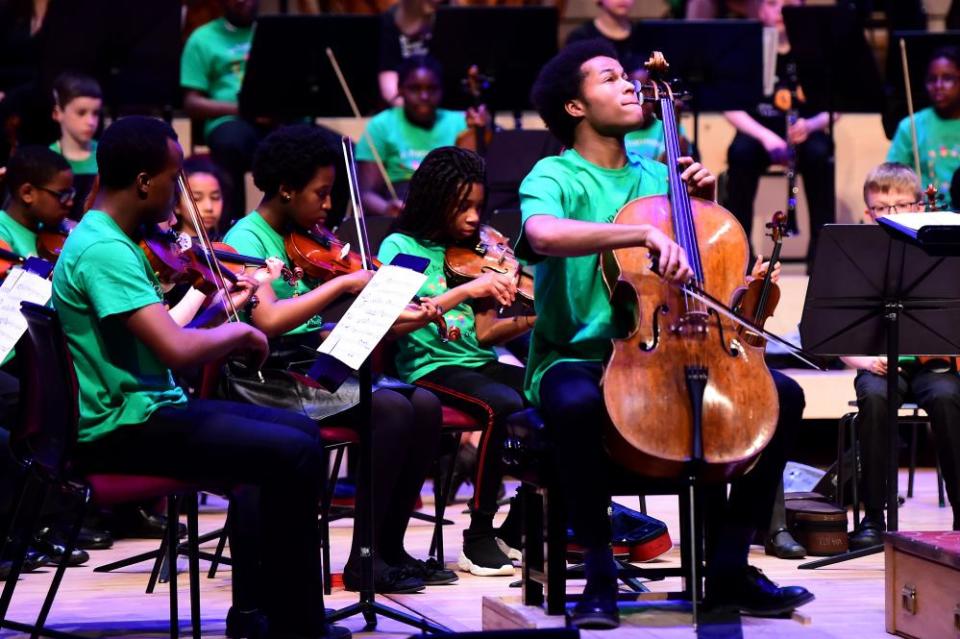The Life of Music review – pushing at the boundaries of the classical canon

Questions thunder down on anyone who writes about music. How to describe abstract sounds in words is the first hurdle. Once every synonym for loud, soft, fast, slow has been exhausted, where next? While the story of a composer’s life is a helpful way in for most of us, others bang their spoons for hermeneutics. Until well into this century, volumes described as “a history of music” habitually began with the births of Bach and Handel in 1685 and petered out around Stravinsky’s Rite of Spring (1913), thus bookending the music most audiences expected to hear in concerts. As for female composers, apart from Clara Schumann and Fanny Mendelssohn, they did not exist.
We have moved backwards and beyond, though with some resulting confusion. Check out the current muddle in university music faculties: is musical notation elitist? (No, yes, don’t know.) Can hip-hop be studied? (Yes. Oxford has had an optional module for a while.) Nicholas Kenyon’s The Life of Music, a project long in gestation that he completed during the pandemic of 2020, generously embraces all, reminding us that “western music” began some four centuries before Bach and introducing us to composers, several of them women, born in the 1980s. The transformative power of digital music is central to his story. So, too, is that vital, ever-changing relationship between composer and performer: notes on the page are only the starting point.
We glimpse the covert Catholic composers in the court of Queen Elizabeth I; Venice in the glory days of Monteverdi
The book’s subtitle, New Adventures in the Western Classical Tradition, makes its soft boundaries clear. As managing director of London’s Barbican Centre, and former director of the Proms, controller of Radio 3 and music critic of the Observer – and therefore a colleague and friend to those of us in the business of classical – Kenyon has heard and programmed as much music as anyone. He can also turn a nimbly pointed sentence with an eye to the story. Whereas The Musical Human by Michael Spitzer, also recently published, goes back some 165m years, exploring whale song or how the size of a bird’s brain relates to its “music”, Kenyon settles for the bone flutes of prehistory as a starting point, with the silver trumpets placed in Tutankhamun’s tomb in the Valley of the Kings as a next stop.
His 300-odd pages are jammed with vivid verbal snapshots (there is, too, a section of judiciously chosen illustrations): we glimpse the covert Catholic composers in the court of Queen Elizabeth I; Venice in the glory days of Monteverdi; lavish entertainments in the court of the Medicis; London in the time of Pepys, as well as Andrew Lloyd Webber; the Paris of Debussy and Satie; the modern-day America of John Adams and Nico Muhly. Beethoven revels in his own chapter, but Bach and Mozart, of whom Kenyon has written separate studies, have to settle for less. As with any survey, essential brevity can result in omission, generalisation or provocation.
Kenyon uses the term tipping point to suggest moments of “seismic shift in musical style”. Inevitably, the need to compress can make these hard to grasp. Not everyone will pick up immediately on the evolution from polyphony to the “sonorous and coherent style based on equal-voiced harmony” that marked the shift from middle ages to Renaissance. If such observations send the reader back to the music to comprehend the point being made, so much the better. Words can only do so much.
The Life of Music is at its lively best when Kenyon’s own passions are laid bare: his affinity with early choral music, his love of Purcell, his irritation at the conservative aesthetics of the philosopher Roger Scruton, his belief, above all, in the power of music to unite individual and community. With its myriad threads of history and argument, the book is an open dialogue between past and present, composer, performer and performance. Its scope might bewilder a musical newcomer but not if they take the many references and suggestions as map and guide. He only warns us off one work: Richard Strauss’s “banal” Sinfonia Domestica. I could have found him a few more horrors, but his honourable task is to persuade. Two pounds from the sale of each book will go to the charity Help Musicians. The more copies sold, the better.
• The Life of Music by Nicholas Kenyon is published by Yale University Press (£18.99). To order a copy go to guardianbookshop.com. Delivery charges may apply

